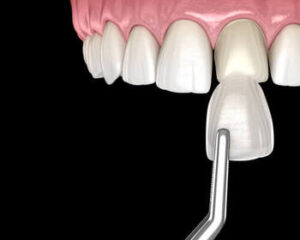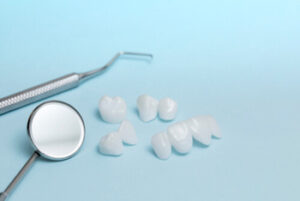When enhancing your smile, veneers are often hailed as the ultimate solution. However, traditional porcelain veneers might not be the perfect fit for everyone. Whether it’s due to cost, the invasive nature of the procedure, or simply personal preference, many seek an alternative to veneers. Luckily, numerous cosmetic dental treatments can achieve remarkable results. This comprehensive guide delves into various alternatives to veneers, helping you find the best approach to achieve your desired bright, natural smile.
The Appeal of Veneers
Veneers, especially porcelain veneers, have been highly esteemed in cosmetic dentistry for their power to transform smiles. These thin shells of porcelain or composite resin are bonded to the frontal surface of teeth, creating a flawless appearance by masking dental flaws like chipped teeth, stained teeth, misaligned teeth, and misshapen teeth. However, the process involves enamel removal and is often irreversible, which makes some patients hesitant. Additionally, traditional porcelain veneers are considered costly, making them an expensive option for many individuals. This brings us to explore the myriad of dental veneer alternatives.
Why Porcelain Veneers Are The Top Cosmetic Choice
Porcelain veneers are considered the top choice for cosmetic dental improvements for several compelling reasons:
- Highly Realistic:
They replicate the light-reflecting properties of natural teeth, providing an extremely natural look.
- Long-Lasting and Stain-Resistant: These veneers are exceptionally durable and stain-resistant, ensuring your smile remains beautiful for years.
- Wide Applicability: They effectively address various dental issues, including chipped, misshapen, or severely discoloured teeth.
- Conservative Procedure: The application process preserves your natural tooth structure more than other treatments.
- Immediate Transformation: Veneers can dramatically enhance your smile in just a couple of dental visits.
For those seeking a comprehensive, durable, and aesthetically superior solution, porcelain veneers remain unparalleled in the field of cosmetic dentistry.
Exploring Dental Bonding: The Popular Alternative to Veneers
One of the most sought-after alternatives to veneers is dental bonding. This cosmetic dental approach involves applying a composite resin material directly to the tooth’s tooth’s surface. The resin is then sculpted and polished to match the natural tooth enamel, providing a seamless blend with your natural teeth.
Benefits of Dental Bonding
– Non-invasive: Unlike veneers, dental bonding typically requires minimal enamel removal, preserving the natural tooth structure.
– Cost-effective: Dental bonding is often a more affordable alternative to veneers, making it accessible to more patients.
– Quick and Convenient: The dental bonding procedure can usually be completed in a single visit to your cosmetic dentist.
Ideal Candidates for Dental Bonding
Dental bonding is perfect for addressing minor cosmetic problems such as small chips, cracks, or gaps between teeth. It is also effective for stained teeth that do not respond well to whitening treatments. However, dental bonding might not be the best solution for severely decayed teeth or those with extensive damage.
Dental Crowns: A Comprehensive Solution
Dental crowns provide a robust alternative to porcelain veneers for those dealing with more significant dental issues. Dental crowns are protective caps fitted over a damaged tooth to regain its original shape, size, and function. They are typically used when a tooth is severely decayed, cracked, or has undergone root canal treatment.
Advantages of Dental Crowns
– Strength and Durability: Dental crowns are incredibly durable and can resist the strain of chewing and biting.
Versatility: They can be used to manage a wide range of dental concerns, including broken teeth and teeth with large fillings.
– Protection: Crowns provide excellent protection for a tooth compromised by injury or decay.
Considerations for Dental Crowns
While dental crowns are an excellent solution for damaged teeth, they require more preparation than dental bonding. The tooth must be reshaped to accommodate the crown, which involves removing a significant amount of the natural tooth structure.
Teeth Whitening: Enhancing Natural Teeth
Teeth whitening treatments are a fantastic alternative for individuals looking to enhance their smile without altering their natural tooth structure. Professional tooth whitening can lighten teeth by several shades, addressing discolouration caused by foods, beverages, tobacco, and ageing.
Types of Teeth Whitening Treatments
– In-office Whitening: This is carried out by a dental professional and can produce dramatic results in a single session.
– At-home Whitening Kits: These are provided by dentists and include custom trays and professional-grade whitening gel for gradual results over a few weeks.
Benefits of Teeth Whitening
– Non-invasive: Teeth whitening does not involve altering the tooth’s surface, making it a straightforward cosmetic procedure.
– Quick Results: Professional whitening treatments offer immediate and noticeable results.
– Affordable: Teeth whitening is relatively inexpensive compared to other cosmetic dental treatments.
Limitations of Teeth Whitening
Teeth whitening is best suited for addressing stained teeth but does not correct structural issues such as chipped or misaligned teeth. It is also important to note that whitening treatments can cause temporary tooth sensitivity.
Orthodontic Treatments: Straightening Crooked Teeth
Orthodontic treatments can be an efficient alternative to porcelain veneers for individuals with misaligned teeth. Traditional metal braces, ceramic braces, and clear aligners like Invisalign are popular methods to achieve a straighter smile.
Advantages of Orthodontic Treatments
– Permanent Solution: Orthodontic treatments provide a long-term solution by correcting the underlying alignment issues.
– Preservation of Natural Teeth: These treatments do not alter the natural tooth enamel.
Options in Orthodontic Treatment
– Metal Braces: Highly effective for severe misalignments but more noticeable.
– Ceramic Braces: These are less noticeable than metal braces, yet just as effective.
– Clear Aligners: Virtually invisible and removable, making them popular for adults.
Considerations for Orthodontic Treatments
While effective, orthodontic treatments require a significant time commitment, often taking months to years to achieve the desired results. They also involve regular visits to the dental professional for adjustments.
Advanced Techniques in Cosmetic Dentistry: Beyond the Basics
As cosmetic dentistry continues to rise, new and innovative techniques are constantly being developed to enhance the appearance of natural teeth. These advanced methods offer additional veneer alternatives, catering to diverse dental needs and preferences. Here, we explore some of the cutting-edge treatments that can serve as alternatives to traditional porcelain veneers, providing patients with even more options to achieve their ideal smile.
Laser Dentistry: Precision and Minimal Invasiveness
Laser dentistry has revolutionised many aspects of dental care, including cosmetic treatments. By using lasers, dentists can perform a variety of procedures with high precision and minimal discomfort.
Applications of Laser Dentistry
– Gum Contouring: 
– Teeth Whitening: Laser-activated whitening treatments can enhance the effectiveness of whitening gels, resulting in quicker and more dramatic results.
– Cavity Preparation: Lasers accurately remove decayed tissue, preserving more of the natural tooth structure.
Enamel Shaping: Sculpting Your Smile
Enamel shaping, also known as enameloplasty or odontoplasty, involves carefully removing small amounts of enamel to alter a tooth’s shape, length, or surface. This technique addresses minor cosmetic issues such as slightly uneven teeth or small chips.
Advantages of Enamel Shaping
– Instant Results: Changes are visible immediately after the procedure.
– Less discomfort: The process usually has minimal pain as it only involves the outer enamel layer.
– Complementary: Enamel shaping can be combined with other treatments like dental bonding for enhanced results.
Gingival Sculpting: Perfecting the Gum Line
Gingival sculpting, or gum reshaping, is a procedure designed to improve the symmetry and contour of the gums. This treatment enhances the smile’s overall appearance, especially when the gum line is uneven or extends too far over the teeth.
Benefits of Gingival Sculpting
– Aesthetic Improvement: Creates a balanced and harmonious gum line, enhancing the look of your teeth.
– Boosts Confidence: A more symmetrical gum line can greatly improve self-esteem and smile aesthetics.
– Quick Recovery: Most patients experience mild discomfort and quick healing times.
Inlays and Onlays: A Middle Ground
Inlays and onlays, also known as partial crowns, repair teeth with moderate decay or damage that does not require a full crown. Made from porcelain, composite resin, or gold, they are custom-made to be attached seamlessly to the specific contours of your tooth.
When to Consider Inlays and Onlays
– Moderate Damage: Ideal for teeth that are too damaged for a filling but not enough for a crown.
– Preservation of Tooth Structure: Inlays and onlays require less tooth removal than full crowns.
– Durability: They provide a durable and long-lasting solution for restoring tooth function and appearance.
Holistic Dentistry: A Natural Approach
Holistic dentistry focuses on the patient’s overall health and well-being, considering how dental health impacts the body as a whole. This approach often involves using biocompatible materials and minimally invasive techniques.
Principles of Holistic Dentistry
– Natural Materials: Preference for materials that are less likely to cause adverse reactions.
– Minimally Invasive: Emphasis on preserving natural tooth structure and promoting overall health.
– Integrated Care: Coordination with other healthcare providers to ensure comprehensive care.
Maintaining Dental Health: The Key to a Bright Smile
Regardless of the cosmetic treatment chosen, maintaining good dental health is essential. Regular dental check-ups, optimal oral hygiene, and a healthy diet play crucial roles in preserving teeth’ natural appearance and prolonging cosmetic treatments’ results.
Tips for Maintaining Dental Health
– Brush and Floss Regularly: Brush twice daily and floss daily to eliminate plaque and prevent tooth decay.
– Routine Dental Visits: Visit your dentist at least twice yearly for professional cleanings and check-ups.
– Healthy Diet: Limit sugary foods and beverages that contribute to tooth decay and gum disease.
– Avoid Tobacco: Smoking and other tobacco use can stain teeth and raise the risk of gum disease.
Preventative Measures: Maintaining Your Smile
Preventative dental care is key for maintaining the health and appearance of your teeth, reducing the need for extensive cosmetic treatments in the future.
Key Preventative Strategies
– Regular Cleanings: The dental professional’s professional cleanings remove plaque and tartar that regular brushing cannot.
– Sealants: Dental sealants can shield the chewing surfaces of the back teeth from decay.
– Fluoride Treatments: Fluoride helps fortify tooth enamel and prevent cavities.
The Role of Technology in Cosmetic Dentistry
Dental technology advancements have significantly improved cosmetic treatments’ effectiveness and efficiency. 3D imaging, CAD/CAM systems, and laser technology have revolutionised dentists’ approaches to cosmetic procedures.
Technological Innovations
– 3D Imaging: Allows for precise planning and simulation of treatments, ensuring optimal results.
– CAD/CAM Systems: Enable the creation of custom restorations such as crowns and veneers with high accuracy.
– Laser Technology: Offers a range of applications from gum reshaping to cavity treatment, with minimal discomfort.
FAQs
- What is the most affordable alternative to traditional porcelain veneers?
Answer: Dental bonding is often the most affordable alternative to traditional porcelain veneers. It involves applying a composite resin material to the teeth to correct minor imperfections, offering a cost-effective solution for enhancing your smile.
- Can teeth whitening treatments address all types of dental stains?
Answer: Teeth whitening treatments are highly effective for removing external stains caused by foods, beverages, and tobacco. However, they may not be as effective for intrinsic stains, which are deeper and may require alternative treatments like dental bonding or veneers.
- How long do dental crowns typically last?
Answer: Dental crowns can last 5 to 15 years, depending on the type of material used and how well they are cared for.
- Is laser dentistry suitable for everyone?
Answer: Laser dentistry is suitable for most patients and can be used for a variety of procedures, including gum contouring and teeth whitening. However, it’s mandatory to consult with your dentist to determine if laser treatments are good for your specific dental needs.
Conclusion: Choosing the Right Alternative to Veneers

Remember, each option offers unique benefits and considerations. By thoroughly exploring these alternatives, you can make an informed decision. However, traditional porcelain veneers are the ultimate choice for a truly transformative and lasting solution. They can provide a stunning, natural-looking smile that significantly enhances your appearance and confidence.
If you’re looking to explore various alternatives to veneers and discover the best treatment options tailored to your specific needs, Dental 266 is here to help. Our team of esteemed dental professionals is dedicated to providing personalised care and advanced cosmetic dental treatments to enhance your smile. Contact us today at 02 9051 0600 to schedule a consultation and uncover how we can help you achieve a bright, natural smile. Let Dental 266 guide you on your journey to a healthier, more confident you.
Sources:
Healthdirect Australia. (n.d.). Dental crown procedure. Retrieved from https://www.healthdirect.gov.au/dental-crown-procedure
Forbes Health. (n.d.). Dental veneers: What you need to know. Retrieved from https://www.forbes.com/health/dental/dental-veneers/
American Association of Orthodontists. (n.d.). Aligners. Retrieved from https://aaoinfo.org/treatments/aligners/
Anwar, R., & Aslam, A. (2008). Oral health status and treatment needs of the population of Karachi. Baqai Journal of Health Sciences, 11(1), 17-22. Retrieved from https://applications.emro.who.int/imemrf/Baqai_J_Health_Sci/Baqai_J_Health_Sci_2008_11_1_17_22.pdf
Healthline. (n.d.). Best practices for healthy teeth. Retrieved from https://www.healthline.com/health/dental-and-oral-health/best-practices-for-healthy-teeth
6.ScienceDirect. (n.d.). Inlays and onlays. Retrieved from https://www.sciencedirect.com/topics/medicine-and-dentistry/inlays-and-onlays


 They replicate the light-reflecting properties of natural teeth, providing an extremely natural look.
They replicate the light-reflecting properties of natural teeth, providing an extremely natural look.



